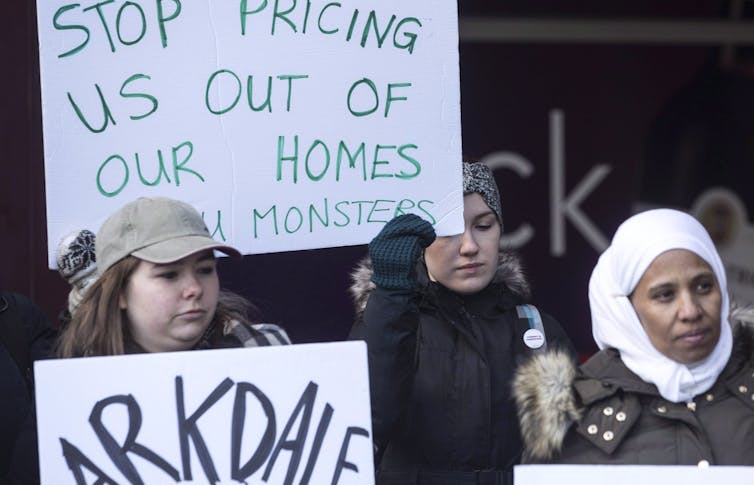
THE CANADIAN PRESS/Chris Young
Howard Ramos, Dalhousie University; Alan Walks, University of Toronto, and Jill L Grant, Dalhousie University
Every crisis shows cracks in the current system and points a glaring spotlight on the inequities that were overlooked before. As rents are due at the end of each month, Canada’s rising neighbourhood and income inequality is hard to ignore.
The COVID-19 pandemic has exacerbated these problems as cities become less affordable. Will the country continue the mistakes of previous decades, leading to even more unequal cities? Or will this crisis offer an opportunity to create truly just cities?
Through the Neighbourhood Change Research Partnership, academics, NGO advocates and municipal policymakers teamed up to document and analyze inequality, income polarization and poverty across seven Canadian cities. The team’s findings show that as governments shifted from traditional welfare state supports to neoliberal policies, cities became increasingly unequal and segregated.

THE CANADIAN PRESS/Chris Young
Rising housing prices
As the country transitioned to a service and knowledge economy during the 1980s and 1990s, it drew more Canadians to cities for work. At the same time, governments deregulated labour, land and financial markets, and promoted private housing construction — all while abandoning the building of social and rental housing.
Old warehouses and urban cores were gentrified during that period. Construction, real estate and finance became increasingly important to the Canadian economy — especially for large Canadian cities.
After the global financial crisis in the late 2000s, low interest rates and federal government guarantees for private mortgage lenders removed financial risk from banks and stimulated a real estate bubble that increased consumer debt levels.
Housing prices rose with these changes, and a greater share of new residential units became small condominiums or apartments. This was particularly the case in downtown neighbourhoods. Meanwhile, buyers in suburban areas continued to prefer detached houses that became more expensive and harder to afford.
Increasing inequality
As a result, income inequality across cities increased. Gini coefficients, the gold standard for measuring inequality by social scientists, show this among individuals and among neighbourhoods between 1980 and 2015.
Inequality, however, is experienced differently across Canadian cities. Toronto saw increasing neighbourhood incomes in its urban core, and declining incomes in its aging inner suburbs that have been outflanked by growth in newly developed areas outside Toronto. Similar patterns were seen in Vancouver and Calgary.
In other cities, things are less extreme. Halifax, for instance, experienced hot spots of inequality.
Across the seven cities studied by the Neighbourhood Change Research partnership, between 13 per cent and 32 per cent of neighbourhoods lost ground. That is, the incomes in those neighbourhoods decreased relative to the average income of a city’s neighbourhoods between 1980 and 2015. Winnipeg had the lowest share of neighbourhoods experiencing decline, while Calgary had the most.
Neighbourhoods losing ground tended to house racialized groups and immigrants in larger cities like Montréal, Toronto and Vancouver. Neighbourhood decline tended to occur in areas with urban Indigenous peoples in Winnipeg, refugees in Hamilton and seniors in Halifax.
Social housing
Government policies affect what is built in neighbourhoods and how income inequality is experienced across cities. Until the 1970s, federal programs supported the building of affordable housing in Canada, but a growing faith in the market to address housing needs undermined that commitment to affordability. By the 1990s, responsibility for social housing was transferred to the provinces. Many of them lacked the resources and the political commitment to invest in social housing.
The federal government instead encouraged building owner-occupied housing. Provincial policies also pushed urban growth and increased pressures on local governments to allow developers to build luxury units.
By the 2010s, Canada transitioned from having some of the most affordable housing markets around the world to among the least affordable. Many Canadians now find themselves shut out of living in the country’s largest cities.
Planning policies and regulations played a key role. As early as the 1970s, Toronto and Vancouver encouraged urban infill and densification in downtown areas that inadvertently stimulated gentrification. It is a trend followed by other cities.
Canadian planners increasingly promoted urban revitalization and regeneration, supported by planning philosophies associated with new urbanism, sustainability, social mix and smart growth — all of which contributed to income polarization across neighbourhoods.
In recent years, programs have been created to renew public housing as seen with Toronto’s Regent Park. These initiatives apply a mix of neoliberal and new-urbanist ideas to generate massive neighbourhood change. The effectiveness of this approach is yet to be seen.
A future housing strategy
In 2017, Canada announced a National Housing Strategy. Since then, $55 billion spread over 10 years has been promised to pursue it. In the face of the COVID-19 outbreak, the federal government implemented new stimulus policies, including a new Insured Mortgage Purchase Program that allows the federal government to buy up mortgages.
The stimulus money aims to ensure that the banks, lenders and construction companies remain profitable during the COVID-19 recession in the hopes that finance and real estate can continue to drive economic growth in the country. But this promotes additional risky lending to buyers of owner-occupied housing with the potential to further imbalance housing markets in Canadian cities, increasing debt levels and making rental housing even less affordable.
A better policy would be to immediately build social housing and affordable rental units. Governments should also continue pandemic-induced policies like limiting loopholes for eviction from commercial and private rental housing. Otherwise, we will face a wave of “renovictions” and rents will continue to be out of reach as entrepreneurs buy up properties in the economic recovery period of the outbreak.
Canada is ripe for implementing bold policies that build affordable housing to meet the diverse needs of its population.
Stimulus spending can have long-term impacts if it protects workers, allows tenants the right to remain in their units and invests in new public transit lines that make cities more sustainable. To fix inequality, we should also consider adopting a universal basic income and other redistributive policies.
We have a real chance at building socially just cities. Let’s not waste it.
Howard Ramos, Professor of Sociology, Dalhousie University; Alan Walks, Professor, Geography, University of Toronto, and Jill L Grant, Professor Emeritus, School of Planning, Dalhousie University
This article is republished from The Conversation under a Creative Commons license. Read the original article.
See also: Gentrification and income inequality the Halifax way – An interview with professor Howard Ramos
With a special thanks to our generous donors who make publication of the Nova Scotia Advocate possible.
Subscribe to the Nova Scotia Advocate weekly digest and never miss an article again. It’s free!



